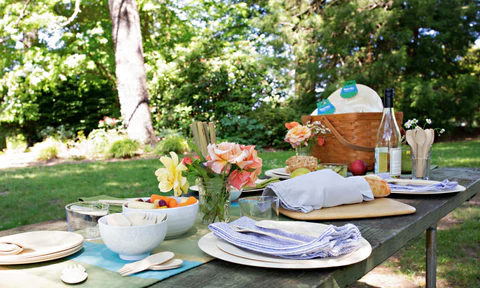
Making eco-conscious choices has become increasingly important in today’s world, and even seemingly small decisions add up. Like the plates we use (even just occasionally). In the United States alone, 1,360,000 disposable plates and cups are tossed in the trash each year.
Whether you opt for disposable plates ordisposable bowls once a year, once a week, or only for special occasions like weddings,, it’s important to understand their impact, as well as alternative options. Using a reusable option is often touted as the most responsible option, and while it often is, there are many factors to consider before deciding on tableware. After the cost of transportation, extra hands to wash, and the water used to clean reusables, a disposable option might be preferred for several reasons. And thanks to new alternatives, going disposable can still be responsible.
Making the sustainable choice shouldn’t be hard. So today, we’re breaking it down for you. What exactly is the difference between disposable plates and compostable plates? What materials are best for the environment, and for your health? And are compostable options always as eco-friendly as they sound? Read on, and find out!
Understanding Disposable vs. Compostable Plates
Disposable plates have been around for decades. They are designed for single use and are usually made from plastic, paper, or styrofoam. Once used, they are thrown away and typically end up in a landfill. Many of these plates take hundreds of years to break down, contributing to pollution and harming wildlife.
Compostable plates, on the other hand, are designed to break down naturally. Made from plant-based materials, they decompose much faster than traditional disposable plates, turning into nutrient-rich soil rather than waste. However, they require specific conditions to compost properly, which means they don’t always break down as easily as people think.
Key Difference:
All compostable plates are disposable, but not all disposable plates are compostable. While both options offer convenience, their environmental impact varies greatly.
Materials Used in Disposable Plates
The type of material a plate is made from determines its environmental impact. Here’s a look at common materials used for traditional disposable plates:
Plastic Plates
Plastic plates are made from petroleum-based materials like polystyrene. While they are durable, lightweight, and water-resistant, they come with serious environmental drawbacks:
- Non-biodegradable: Plastic does not break down naturally. Instead, it turns into microplastics that pollute the environment.
- Recycling Challenges: Most plastic plates are not recyclable because they are made from low-quality plastic.
- Harm to Wildlife: Plastic waste often ends up in oceans and rivers, where it can harm animals.
Coated Paper Plates
Paper plates may seem like an eco-friendly choice, but most are coated with a thin layer of plastic or chemicals to prevent them from soaking through.
- Tree Consumption: Producing paper plates requires cutting down trees, which contributes to deforestation.
- Chemical Coatings: Many paper plates contain harmful chemicals, making them non-compostable and unsafe for recycling.
- Short Lifespan: Unlike plastic, coated paper plates degrade faster, but they still contribute to waste.
Styrofoam Plates
Styrofoam is another common disposable material, but it is considered one of the worst options for the environment.
- Extremely Long Lifespan: Styrofoam plates can last for hundreds of years in landfills.
- Breaks Into Tiny Pieces: It crumbles easily, making it one of the biggest contributors to microplastic pollution.
- Difficult to Recycle: Most recycling centers do not accept styrofoam, meaning nearly all of it ends up in the trash.
Materials Used in Compostable Plates
Compostable plates are made from natural, biodegradable materials that break down quickly when disposed of correctly. Here are some of the most common materials used:
Sugarcane Bagasse
Bagasse is the fibrous material left after sugarcane is processed. Instead of being discarded, it is used to make compostable plates.
- Plant-Based: Since it’s made from agricultural waste, bagasse is an eco-friendly option.
- Quick Decomposition: In the right conditions, bagasse plates break down within 90 days.
- Chemical Concerns: Some bagasse plates are coated with chemicals, making them non-compostable. Be sure to check for certifications before purchasing.
Plant Fiber
Some compostable plates are made from fast-growing plant fibers, such as bamboo or wheat straw.
- Tree-Free Alternative: These plates do not require cutting down trees, making them a more sustainable option.
- Lightweight But Flimsy: They are biodegradable but may not hold up well with heavy or greasy foods.
- Water-Intensive Production: Producing plant fiber plates requires a lot of water, which may not always be sustainable.
Bamboo
Bamboo is one of the most sustainable materials used for disposable plates.
- Fast-Growing: Bamboo regenerates quickly without the need for replanting.
- Durable and Sturdy: Unlike paper plates, bamboo plates are strong enough to hold wet and heavy foods.
- Compostable and Chemical-Free: They naturally resist moisture and do not require chemical coatings.
Palm Leaf Plates
Palm leaf plates are made from fallen leaves that are collected, cleaned, and pressed into shape.
- 100% Natural: They do not contain additives or chemicals.
- Unique Appearance: Each plate has a natural texture and color, which some people find appealing.
- Limited Composting Information: Many palm leaf plates are not certified compostable, making disposal options unclear.
What Happens After Use?
Disposable Plates
- Plastic and Styrofoam: These plates end up in landfills, taking hundreds of years to break down.
- Coated Paper: Non-recyclable and non-compostable, meaning they also go to landfills.
- Environmental Impact: Most disposable plates contribute to long-term pollution.
Compostable Plates
- Commercial Composting Needed: Many compostable plates require industrial composting facilities.
- Home Composting: Some bamboo and plant fiber plates can break down naturally in a home compost bin.
- Better for the Planet: When composted properly, these plates turn into nutrient-rich soil.
Cost and Availability
Traditional disposable plates are cheaper and more widely available than compostable plates. You can find them in almost any grocery store at a low price. However, the long-term environmental cost is high.
Compostable plates are typically more expensive, but they are becoming more accessible. Buying in bulk can help reduce costs. While they still require resources to produce, they offer a much cleaner alternative to plastic and styrofoam.
Which Option Is Best for You?
When deciding between disposable and compostable plates, consider your priorities:
- For the Environment: Compostable plates are the clear winner.
- For Convenience: Traditional disposable plates are widely available and affordable.
- For Durability: Bamboo plates provide the strongest and most sustainable option.
If possible, choose compostable plates made from bamboo or certified plant fibers. And whenever you can, compost them properly to ensure they break down naturally.
By making informed choices, you can enjoy the convenience of disposable tableware while reducing your impact on the planet. Every small step counts!






More Stories
Do You Want to Improve the Exteriors of Your Home?
Why Hiring an Interior Designer in Minneapolis is Worth the Investment
Create a Spacious and Stylish Bathroom With Frameless Glass Shower Screens